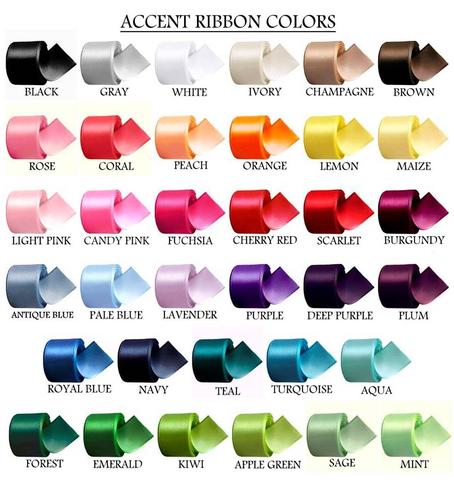Ribbon Colors may be a special order and take longer to arrive. Please check with me to make certain we have you color choices in stock or that we can order them to arrive in time to meet your date needed.

The Science of Colors: Decoding the Meaning and Significance of Each Hue on a Color Chart Colors have been an integral part of human history, shaping our emotions, thoughts, and perceptions in ways we don't always realize. From the clothes we wear to the products we buy, everything around us is influenced by the science of colors. But have you ever wondered why certain colors evoke specific emotions and reactions? Or why some colors are more popular than others in branding and advertising? The answer lies in the meaning and significance of each hue on a color chart. By understanding the science of colors, we can decode the hidden messages behind each shade and use them to our advantage. So, let's dive deep into the world of colors and explore the psychology and symbolism behind each hue. Whether you're a designer, marketer, or simply someone who loves colors, this article will open your eyes to the fascinating world of color science. The history of color psychology Color psychology is the study of how colors affect human behavior and emotions. This field of study has been around for centuries and can be traced back to ancient cultures such as the Egyptians, Greeks, and Chinese. The Egyptians used colors in their artwork to represent different deities, while the Greeks believed that colors could influence a person's mood and health. In traditional Chinese medicine, colors were used to balance and harmonize the body's energy. In the 19th century, German poet Johann Wolfgang von Goethe published a book called "Theory of Colors," which explored the emotional and psychological effects of colors. This book laid the foundation for modern color psychology, which is now widely used in marketing, advertising, and design. Today, color psychology is a complex field that involves the study of color perception, cultural influences, and individual experiences. Researchers have found that colors can influence everything from our mood and emotions to our buying decisions and brand perceptions. The meaning and significance of red Red is a bold and passionate color that symbolizes energy, action, and excitement. It is often associated with love, anger, and danger. In Western cultures, red is commonly used in Valentine's Day cards, stop signs, and emergency lights. In marketing and advertising, red is often used to grab attention and create a sense of urgency. It is commonly used in clearance sales, fast-food logos, and sports teams. However, red can also be overwhelming and aggressive if used too much. The meaning and significance of orange Orange is a vibrant and energetic color that symbolizes warmth, joy, and enthusiasm. It is often associated with autumn, Halloween, and citrus fruits. In Western cultures, orange is commonly used in sports teams, construction sites, and safety equipment. In marketing and advertising, orange is often used to create a sense of excitement and playfulness. It is commonly used in food and beverage logos, travel agencies, and children's products. However, orange can also be seen as cheap or low-quality if used improperly. The meaning and significance of yellow Yellow is a cheerful and optimistic color that symbolizes happiness, creativity, and intelligence. It is often associated with sunshine, daisies, and smiley faces. In Western cultures, yellow is commonly used in caution signs, school buses, and road construction. In marketing and advertising, yellow is often used to grab attention and create a sense of positivity. It is commonly used in food and beverage logos, technology products, and home decor. However, yellow can also be seen as cheap or overly cheerful if used too much. The meaning and significance of green Green is a calming and refreshing color that symbolizes growth, balance, and nature. It is often associated with forests, grass, and money. In Western cultures, green is commonly used in environmental organizations, healthcare facilities, and financial institutions. In marketing and advertising, green is often used to create a sense of harmony and eco-friendliness. It is commonly used in food and beverage logos, beauty products, and fashion. However, green can also be seen as boring or unexciting if used improperly. The meaning and significance of blue Blue is a calming and trustworthy color that symbolizes loyalty, intelligence, and serenity. It is often associated with the sky, ocean, and ice. In Western cultures, blue is commonly used in healthcare facilities, social media logos, and law enforcement. In marketing and advertising, blue is often used to create a sense of trust and reliability. It is commonly used in finance, technology, and travel industries. However, blue can also be seen as cold or distant if used too much. The meaning and significance of purple Purple is a royal and luxurious color that symbolizes creativity, spirituality, and wisdom. It is often associated with grapes, lavender, and amethyst. In Western cultures, purple is commonly used in beauty products, education institutions, and spirituality. In marketing and advertising, purple is often used to create a sense of sophistication and elegance. It is commonly used in fashion, beauty, and luxury industries. However, purple can also be seen as too feminine or elitist if used improperly. The meaning and significance of pink Pink is a gentle and feminine color that symbolizes love, compassion, and innocence. It is often associated with roses, cotton candy, and baby girls. In Western cultures, pink is commonly used in breast cancer awareness campaigns, Valentine's Day, and baby products. In marketing and advertising, pink is often used to create a sense of sweetness and femininity. It is commonly used in fashion, beauty, and health industries. However, pink can also be seen as too girly or superficial if used too much. The meaning and significance of black Black is a powerful and mysterious color that symbolizes sophistication, elegance, and strength. It is often associated with darkness, night, and mourning. In Western cultures, black is commonly used in formal wear, luxury products, and high-end technology. In marketing and advertising, black is often used to create a sense of exclusivity and luxury. It is commonly used in fashion, beauty, and automotive industries. However, black can also be seen as too serious or gloomy if used improperly. The meaning and significance of white White is a pure and clean color that symbolizes innocence, simplicity, and peace. It is often associated with snow, clouds, and wedding dresses. In Western cultures, white is commonly used in healthcare facilities, cleaning products, and religious ceremonies. In marketing and advertising, white is often used to create a sense of purity and simplicity. It is commonly used in fashion, beauty, and home decor industries. However, white can also be seen as too sterile or boring if used too much. How to use color psychology in branding and marketing Now that we have explored the meaning and significance of each hue on a color chart, let's talk about how to use color psychology in branding and marketing. First, it's important to understand your target audience and the emotions you want to evoke. For example, if you are targeting a younger audience, you may want to use bright and playful colors like orange and yellow. If you are targeting a more mature audience, you may want to use sophisticated and elegant colors like black and purple. Second, consider the context and industry you are in. For example, if you are in the healthcare industry, you may want to use calming and trustworthy colors like blue and green. If you are in the food industry, you may want to use appetite-stimulating colors like red and orange. Third, experiment with color combinations to create a cohesive and memorable brand identity. For example, McDonald's uses a combination of red and yellow to create a sense of excitement and playfulness, while Coca-Cola uses a combination of red and white to create a sense of tradition and nostalgia. Color combinations and their meanings Color combinations can also have their own meanings and associations. Here are a few examples: Red and yellow: excitement and playfulness (McDonald's) Blue and yellow: reliability and warmth (Best Buy) Black and white: sophistication and simplicity (Chanel) Green and brown: nature and eco-friendliness (Starbucks) Red and white: tradition and nostalgia (Coca-Cola) Conclusion Colors are a powerful tool that can influence our emotions, thoughts, and perceptions in ways we don't always realize. By understanding the meaning and significance of each hue on a color chart, we can use color psychology to our advantage in branding and marketing. Whether you are a designer, marketer, or simply someone who loves colors, this article has hopefully opened your eyes to the fascinating world of color science. So the next time you choose a color for your brand or product, remember the hidden messages behind each shade and use them to create a memorable and effective message.

